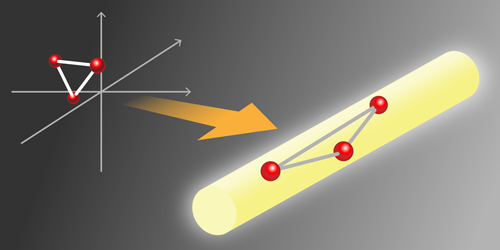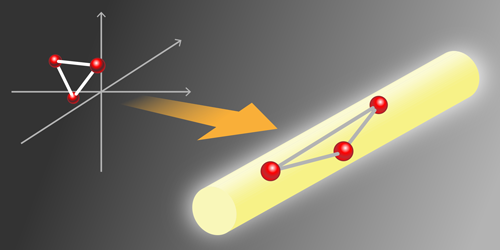Three-Body Problem Solved for 1D Boson Trio
The three-body system is the epitome of a problem that resists a solution. But some specific cases of three interacting objects have been solved analytically. One example is three bosons. Under certain conditions, interactions between the bosons lead to a solvable three-body bound state called a trimer. New theoretical work by three separate groups describes a previously unidentified trimer in a three-boson system confined to one dimension. Experimental verification of this bound-state prediction could be done using cold atoms in a linear trap.
Bosons are a rich system for studying few-body physics. For three bosons in three dimensions, there exists a series of trimer states, called Efimov states, which have been observed in cold atoms. Calculations predict another trimer state for bosons that are confined in one dimension and that interact through a short-range, two-body force. However, in a real trap or waveguide, the bosons will still be able to move a little bit in the other dimensions. Three different groups have now investigated the effect of this transverse motion on the binding energy of the bosons.
In one study, Ludovic Pricoupenko from Sorbonne University in France started with a model for 3D Efimov states and then calculated how these states evolve when an atomic waveguide potential is applied. In this “quasi-1D system,” where transverse excitations play a role, Pricoupenko predicts that there exists an excited trimer state that doesn’t appear in idealized 1D systems.
A slightly different strategy was used in two other studies, one by Dmitry Petrov from the University Paris-Sud and colleagues and the other by Yusuke Nishida from the Tokyo Institute of Technology in Japan. These researchers confined the bosons in a strict 1D configuration, but they included an effective three-body force that accounts for transverse excitations. Three-body forces are usually very weak compared with the two-body forces in the same system, but the researchers showed that boson systems can be tuned so that the three-body force plays an observable role. For a 1D three-boson system, their calculations returned the same excited trimer state as that found by Pricoupenko.
This research is published in Physical Review A.
–Michael Schirber
Michael Schirber is a Corresponding Editor for Physics based in Lyon, France.





